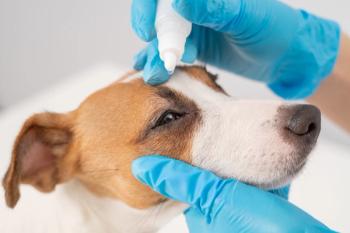
Leaders eye downscaled plan to aid rural veterinarians
Veterinary leaders plan to pitch a $1-million program to Congress, calling for educational debt relief for DVMs who practice in underserved and largely rural areas of the United States.
Veterinary leaders plan to pitch a $1-million program to Congress, calling for educational debt relief for DVMs who practice in underserved and largely rural areas of the United States.
It's a strategy designed to mimic, on a smaller scale, the National Veterinary Medical Services Act (NVMSA), which authorizes the Secretary of Agriculture to provide loan repayment for DVMs filling shortage situations. The $60-million program, signed by President Bush in December, currently sits idle due to federal budget cuts that have strapped the United States Department of Agriculture (USDA) and choked new project initiatives.
The cheaper "pilot program" has better odds of gaining funds to address the mounting shortage of veterinarians practicing in rural areas of the United States, proponents say. While the American Veterinary Medical Association (AVMA) reports no rural DVM numbers, new graduate information and anecdotal accounts blame salary gaps for the profession's migration from small-town farm service to urban pet practice.
Dr. Michael Chaddock
A lack of practitioners, particularly in food animal medicine, might lead to a national security threat, says Dr. Michael Chaddock, director of the AVMA's Governmental Relations Division (GRD).
"Veterinarians recognize disease outbreaks and monitor the nation's food supply," he says. "Not having them in these roles leaves the country vulnerable. We're turning over every leaf and rock to try and convince Congress how important this is."
At the state level
Educational debt aid is a viable means to attract new graduates to rural areas, thereby shoring up the nation's defenses, GRD assistant director Dr. Ray Stock says. But as AVMA officials continue to push Congress, state leaders seeking more immediate relief are opting to circumvent the federal initiative.
Dr. Ray Stock
At presstime, a handful of states were considering offering incentives for veterinarians interested in rural practice. The latest, Ohio, is attempting to tack on student debt relief to an already bulging state budget bill (see related story). Tennessee practitioners are championing legislation that, if passed, would reserve seats at the University of Tennessee's veterinary college for students with agricultural backgrounds (see DVM Newsmagazine's April issue). And while Missouri veterinary leaders were successful last year in getting a statewide loan repayment program passed, legislators have not allocated dollars to feed the initiative — a similar obstacle for NVMSA.
"We continue to try to get funding, but the budget's been so tight the program hasn't got a prayer," says Richard Antweiler, executive director of the Missouri Veterinary Medical Association (MVMA).
National approach
That's not such a bad thing, says Dr. John Thomson, dean of Iowa State University's (ISU) veterinary college. Credited with championing NVMSA, Thomson argues that a shortage of rural veterinarians is solely a federal issue.
Richard Antweiler
"This issue has national ramifications," he says. "I really think that by addressing this state by state, we'll have some very deficient regions in the country. I think we need to approach this nationally. If we want this taken care of, it has to come at the federal level."
Thomson, a former small-town practitioner who's spent six years analyzing the rural veterinarian shortage, says the new proposal before Congress requests $1 million in startup costs to pick up a portion of the educational debt load of 18 veterinarians. Nine yet-to-be-determined states each would receive two of the selected DVMs for three years. If lawmakers allocate funding, the remaining $59 million for the full project might follow, Thomson says.
"I feel very confident that if they give us 18 veterinarians, we can track for a couple years, we'll be able to show the benefits of what this project can do," he says. "This is a way for us to strengthen our rural infrastructure in this country. I think we'll be able to substantiate why this needs to be fully funded in the future. It's the right thing for our nation."
Dr. John Thomson
Tracking veterinarians
Dr. Pat Halbur agrees. As ISU's interim associate dean for Public Service and Outreach, he's engaged students in a letter-writing campaign to push Washington lawmakers on NVMSA. To back their efforts, Halbur touts a 2003 ISU assessment survey, which anticipates at least 120 rural veterinarians will be required to serve Iowa's needs in the next five to seven years.
Survey results cite lack of interest as the main reason veterinarians choose not to pursue food animal medicine. But the data also reveals practitioners in towns of less than 5,000 residents lead fulfilling, productive careers, Halbur says.
"The details are interesting," he says. "Most respondents were satisfied with their income and quality of life. It shows a career in food animal practice isn't as bad as some people might suspect."
Newsletter
From exam room tips to practice management insights, get trusted veterinary news delivered straight to your inbox—subscribe to dvm360.




